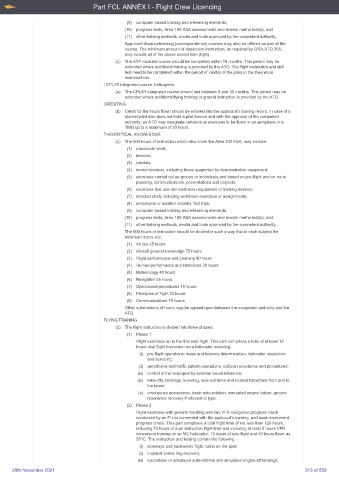Page 313 - UK Aircrew Regulations (Consolidated) 201121
P. 313
Part FCL ANNEX I - Flight Crew Licencing
(9) computer-based training and e-learning elements;
(10) progress tests, Area 100 KSA assessments and mental maths test(s); and
(11) other training methods, media and tools approved by the competent authority.
Approved distancelearning (correspondence) courses may also be offered as part of the
course. The minimum amount of classroom instruction, as required by ORA.ATO.305,
may include all of the above except item (b)(9).
(c) The ATP modular course should be completed within 18 months. This period may be
extended where additional training is provided by the ATO. The flight instruction and skill
test need to be completed within the period of validity of the pass in the theoretical
examinations.
I CPL/IR integrated course: helicopters
(a) The CPL/IR integrated course should last between 9 and 30 months. This period may be
extended where additional flying training or ground instruction is provided by the ATO.
CREDITING
(b) Credit for the hours flown should be entered into the applicant’s training record. In case of a
student pilot who does not hold a pilot licence and with the approval of the competent
authority, an ATO may designate certain dual exercises to be flown in an aeroplane or a
TMG up to a maximum of 20 hours.
THEORETICAL KNOWLEDGE
(c) The 500 hours of instruction which also cover the Area 100 KSA, may include:
(1) classroom work;
(2) lessons;
(3) tutorials;
(4) demonstrations, including those supported by demonstration equipment;
(5) exercises carried out as groups or individuals and based on pre-flight and en-route
planning, communications, presentations and projects;
(6) exercises that use demonstration equipment or training devices;
(7) directed study including workbook exercises or assignments;
(8) aerodrome or aviation industry field trips;
(9) computer-based training and e-learning elements;
(10) progress tests, Area 100 KSA assessments and mental maths test(s); and
(11) other training methods, media and tools approved by the competent authority.
The 500 hours of instruction should be divided in such a way that in each subject the
minimum hours are:
(1) Air law 25 hours
(2) Aircraft general knowledge 75 hours
(3) Flight performance and planning 80 hours
(4) Human performance and limitations 20 hours
(5) Meteorology 40 hours
(6) Navigation 55 hours
(7) Operational procedures 15 hours
(8) Principles of flight 35 hours
(9) Communications 15 hours
Other subdivisions of hours may be agreed upon between the competent authority and the
ATO.
FLYING TRAINING
(d) The flight instruction is divided into three phases:
(1) Phase 1:
Flight exercises up to the first solo flight. This part comprises a total of at least 12
hours dual flight instruction on a helicopter including:
(i) pre-flight operations: mass and balance determination, helicopter inspection
and servicing;
(ii) aerodrome and traffic pattern operations, collision avoidance and procedures;
(iii) control of the helicopter by external visual reference;
(iv) take-offs, landings, hovering, look-out turns and normal transitions from and to
the hover;
(v) emergency procedures, basic auto-rotation, simulated engine failure, ground
resonance recovery if relevant to type.
(2) Phase 2:
Flight exercises until general handling and day VFR navigation progress check
conducted by an FI not connected with the applicant’s training, and basic instrument
progress check. This part comprises a total flight time of not less than 128 hours,
including 73 hours of dual instruction flight time and including at least 5 hours VFR
conversion training on an ME helicopter, 15 hours of solo flight and 40 hours flown as
SPIC. The instruction and testing contain the following:
(i) sideways and backwards flight, turns on the spot;
(ii) incipient vortex ring recovery;
(iii) touchdown or advanced auto-rotation and simulated engine-off landings,
20th November 2021 313 of 558

